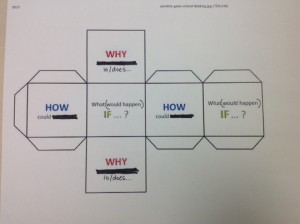Last week we finished Act II of Macbeth, and I wanted to do something different for our discussion. We tried Socratic Smackdown for Act 1, which worked pretty well for its debut in my classroom, but I wasn’t ready to repeat that right away. So I did a little combining of good ol’ fashioned dice throwing and Today’s Meet.
I started with “The Question Game” from @TeachThought. Using the diagram provided, I created dice with question starters on each face. I can’t say the dice were too fancy–paper, glue stick, packing tape for lamination, and a couple paper clips thrown in the middle for a some low-budget sound effects.
I also adjusted the questions a bit. Here’s a photo of my template below:
After that, I split the class into groups, and they played three rounds of “The Question Game.” No fancy rules. You roll the die, then create a question using that question starter. Someone in the group serves as the recorder and writes the questions down. Group members are allowed to help provide ideas. At the end, the group circled their 2-3 favorite questions to discuss in the “Today’s Meet” chat the next day.
The game is just that simple. The students had much more fun, though, than if I’d given them a sheet of paper and said, “Write down at least 12-15 deep questions about the play Macbeth through Act II.”
Why?
It’s all about the game. Not much of a game, you say? I’d agree. But that slight anticipation of what question starter you’ll roll–that makes all the difference. Plus, students started thinking of questions ahead of time, then hoping they’d roll that question starter. That made the stakes higher. Since members were allowed to help, students had to decide whether to give up their prize question to another student so that it would be on the list (and hopefully chosen for the chat), or whether to keep it in case the next time they rolled that question starter.
Will I do this again? Absolutely. I may make new dice with different question starters to change it up, but it was a great way to encourage deep question forming.





